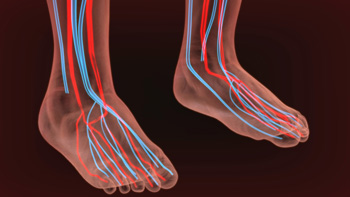 Research has indicated that high blood sugar levels may be a common reason for poor circulation to occur in diabetic patients. Diabetes may cause blood vessels to gradually become damaged, and this may lead to decreased circulation. There are several symptoms that are associated with this condition, including a loss of sensation, which may begin with a feeling of pins and needles in the lower extremities; an awareness of hot or cold temperatures in the feet; or a decreased pain level, which may make it difficult to notice any sores or wounds. There are certain measures that may be taken to possibly prevent or help this ailment, including performing mild exercises and stretching techniques, wearing supportive shoes and socks, and keeping your cholesterol and blood pressure at normal levels. If you believe you have poor circulation, it is advised to speak with a podiatrist who can determine what the best course of treatment is for you.
Research has indicated that high blood sugar levels may be a common reason for poor circulation to occur in diabetic patients. Diabetes may cause blood vessels to gradually become damaged, and this may lead to decreased circulation. There are several symptoms that are associated with this condition, including a loss of sensation, which may begin with a feeling of pins and needles in the lower extremities; an awareness of hot or cold temperatures in the feet; or a decreased pain level, which may make it difficult to notice any sores or wounds. There are certain measures that may be taken to possibly prevent or help this ailment, including performing mild exercises and stretching techniques, wearing supportive shoes and socks, and keeping your cholesterol and blood pressure at normal levels. If you believe you have poor circulation, it is advised to speak with a podiatrist who can determine what the best course of treatment is for you.
While poor circulation itself isn’t a condition; it is a symptom of another underlying health condition you may have. If you have any concerns with poor circulation in your feet contact one of our podiatrists of James Kutchback, DPM, CWS-P. Our doctors will treat your foot and ankle needs.
Poor Circulation in the Feet
Peripheral artery disease (PAD) can potentially lead to poor circulation in the lower extremities. PAD is a condition that causes the blood vessels and arteries to narrow. In a linked condition called atherosclerosis, the arteries stiffen up due to a buildup of plaque in the arteries and blood vessels. These two conditions can cause a decrease in the amount of blood that flows to your extremities, therefore resulting in pain.
Symptoms
Some of the most common symptoms of poor circulation are:
- Numbness
- Tingling
- Throbbing or stinging pain in limbs
- Pain
- Muscle Cramps
Treatment for poor circulation often depends on the underlying condition that causes it. Methods for treatment may include insulin for diabetes, special exercise programs, surgery for varicose veins, or compression socks for swollen legs.
As always, see a podiatrist as he or she will assist in finding a regimen that suits you. A podiatrist can also prescribe you any needed medication.
If you have any questions, please feel free to contact our offices located in The Woodlands and Woodville, TX . We offer the newest diagnostic and treatment technologies for all your foot care needs.



